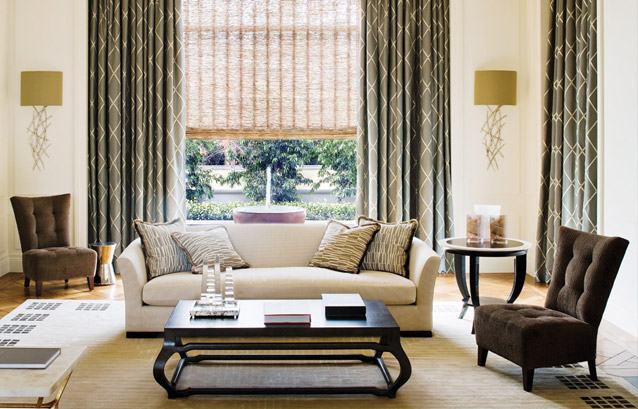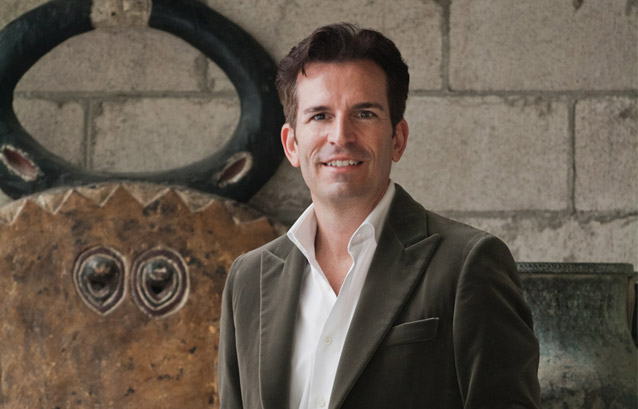What attracted you to the world of design and architecture?
Design was always in my blood. As a young child, I stayed inside building homes / models out of anything I could find – Lego, cardboard etc. As soon as I could leave Virginia for the ‘bright lights’ of New York and design school I was off – I have never looked back.
Who are the people alive or dead that you think are/were truly inspirational?
I find inspiration in so many people around the globe – in London there was of course Tom Parr and David Hicks and currently Veere Grenney; in New York the list goes on but John Saladino and Mica Ertegun for their timeless interiors; in Los Angeles there is Rose Tarlow and Michael Smith and in Sydney my great friend Michael Love never stops inspiring me. And of course the late Albert Hadley whose contemporary eye was way ahead of his time.

Thomas’s signature residence, featuring an over-scale ebony bed from John Hobbs, London and an Anglo-Ceylonese breakfront wardrobe.
How would you describe your signature style?
I do try not to have a signature style but instead to create a unique vision for each home based on the client’s own style. Of course there are always some similarities, which come mainly from my pared back, edited approach – less is more but I try to add a new ‘twist’ to each project.
What matters to you most in the work that you do?
Paramount to my work is that clients feel comfortable in their new surroundings – they must love and have pride – this in turn makes them much more gracious hosts. No money can repay the feeling I have when I get the thank you calls from clients after they (and their friends and family) have enjoyed time together in their home.

Windows in the sitting room of a Melbourne residence reveal views to the garden and a water feature. Pocketed curtains and custom-made woven blinds from Conrad, US, filter the northern light.
Do you have a favourite residential project?
I would have to say my own apartment would have to be my favourite project. Not only is the sense of accomplishment that this is ‘mine’, but it is fun to have this experimental canvas to work upon, always in a state of development. It is fun to look back at photos of how the interiors have evolved and will continue to do so.
What is your design pet hate?
I am not a fan of gimmicky items or trends. Attention seeking is not in my nature so I couldn’t have rooms or items that scream too loudly. I am a fan of harmony – a calm mixture of items to create a whole.
What do you think works without fail?
Every room needs a few handmade items – I always add baskets, woven cane items, ethnic pieces to give a room a more casual edge. Even an 18th century gilt English table can feel less intimidating with a Japanese basket placed on it.
You oversee a team of employees – what do you look for in the people you work with?
We are all so different and have different strengths and weaknesses – it is not always easy but I strive to develop the various personal strengths in my team. I try to educate and make everyone grow rather than lecturing to them. Clients say I would be a great father although I don’t think that is on the cards.

The entrance hall of a Melbourne residence, with coffered ceiling and bronze inlaid black beam timber panelling. The commissioned cascade chandelier by Sharon Marston, London, hangs above an Art Deco oval centre table.
You have had much peer recognition over the years. Is there a key moment that matters most?
The publication of my book Residence in 2010 was certainly a landmark. The incredible positive feedback from my peers across the globe has been overwhelming. To open a magazine and see my book featured in a designer’s own home – WOW – what a compliment. Residence has been spotted in British House & Garden at the bottom of Jane Churchill’s bed, in USA Elle Décor on a console in an incredibly grand interior in Madrid and most recently next to Tom Ford and Christian Liaigre’s books in an interior in Notting Hill, London.
What would the future bring that would make your career complete?
I look forward to continuing my work in similar strides – bringing further acknowledgement to Australian design internationally is especially important to me. We offer so much to the world and the time is here for this to be acknowledged – I feel so grateful calling Australia home.
Thomas Hamel & Associated
www.thomashamel.com
Photography: Matt Lowden
mattlowdenart.com
Become a member of Temple & Webster at templeandwebster.com.au/habitus and enjoy $15 off your first purchase with code HABITUS!

